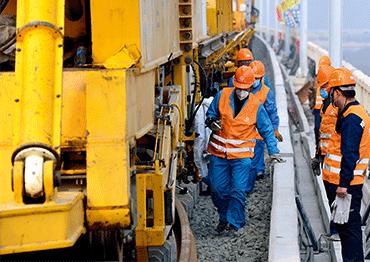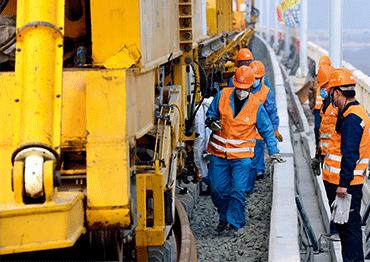At a time when most Chinese provinces are waiting out the novel coronavirus epidemic, infrastructure investment has become a priority to offset its impact and boost sustainable economic growth.
As of March 8, at least 23 provinces and municipalities across the country have added infrastructure projects to their 2020 government work reports. So far, 20 have unveiled specific amounts of investment totaling 44 trillion yuan (US$6.3t).
Over the years, massive infrastructure investment has been a major solution for China to cope with natural disasters and economic meltdowns such as the Asian economic crisis (1997), the SARS epidemic (2003) and global economic crisis (2008).
Zhao Quanhou, director of the Financial Research Center of the Chinese Academy of Fiscal Sciences, argued that times have changed since China rolled out its ambitious 4 trillion yuan (US$571b) stimulus package in 2008. Back then, when domestic supply exceeded demand, overseas markets offered a release valve. Nowadays, oversupply, trade disputes and reduced demand require investments to be more effective and efficient. As a result, overlaps between government and private investment are unlikely anytime soon.
China will accelerate its “new infrastructure” projects including 5G networks, data centers, artificial intelligence (AI) and industrial internet, according to a meeting of the Standing Committee of the Political Bureau of the Communist Party of China Central Committee on March 4.
Tang Daosheng, senior executive vice president at Tencent, said that just as SARS and personal computers drove internet growth in 2003, the coronavirus epidemic is speeding up development of the industrial internet.
“The new rounds of infrastructure investment mainly aim to address weak links in the current infrastructure at a time when China’s urbanization is fast tracked and supply-side reform is underway,” Zhao Quanhou told NewsChina. In October 2018, China’s State Council announced it would improve weak links in areas including railways, expressways, waterways, irrigation systems, energy, airports, ecological protection and urban renovation.
“China has continued to adjust its areas of infrastructure investment, but according to the new State Council documents, traditional areas like railways and expressways remain top priorities,” Zhao said.
On December 26, 2019, the Ministry of Transport said that in 2020, it would complete its 800 billion yuan (US$114b) investment in railways, 1.8 trillion yuan (US$257b) in roads and waterways, and 90 billion yuan (US$12.9b) in civil aviation.
Among the provinces that have announced infrastructure investment projects, Guangdong Province has pledged the most-5.9 trillion yuan (US$842b) for 1,230 projects, official data shows. Yunnan Province will invest 5 trillion yuan (US$714b) in its 525 projects, followed by Sichuan Province and Chongqing municipality, where more than half of the city’s investment will flow to transportation, public facilities, irrigation, environmental protection, energy and telecommunications.
Zhao said in recent years, a greater proportion of government investment has gone to China’s relatively less-developed central and western areas. In the densely populated provinces of the east and municipalities, transportation investment has saturated. At most some relatively marginal investments have remained, such as Beijing Daxing International Airport.
“New infrastructure” investment, which spotlights innovations such as 5G, electric vehicles and cloud computing, was proposed at the Central Economic Working Conference in late 2018.
According to Ren Zeping, chief economist of the Evergrande Group, the latest round of investments has focused on new fields such as 5G and AI. Also, inter-city transport between emerging city clusters are a focus as China’s urbanization rate is set to reach 71 percent by 2030. Ren added that intensive modes of economic growth will be pursued, and private investors will play an increasingly important role.
The coronavirus has exposed the shortcomings of public facilities in many provinces. While the city of Wuhan, Hubei Province, the epicenter of the epidemic, is home to 11 million people, its allocated medical resources and emergency response capabilities proved too weak to deal with the outbreak.
Investment in public infrastructure has since been a focus for many provinces. For example, East China’s Shandong Province has focused on areas including public health, emergency response systems, emergency material reserves, cybersecurity, vaccine development and the industrial chain for medical supplies, totaling more than 892 billion yuan (US$127b) on 274 key projects.
In November 2008, the central government rolled out 10 major measures to expand domestic demand and stabilize economic growth during the global economic crisis. As of the end of 2010, 4 trillion yuan (US$571b) in investments were largely in place. In 2008, China’s general budget revenues exceeded 6 trillion yuan (US$857b).
According to the National Development and Reform Commission, China’s top economic planner, the central government accounted for 1.18 trillion yuan (US$168b) in total investment volume, while the remainder came from local governments, debt bonds, policy-related loans, enterprise bonds and private investment.
At the time, loopholes in financial regulations such as shadow banking, lax management of local investment and financing institutions were prevalent. This resulted in a spate of fiscal and debt risks that still linger to this day. The 2008 stimulus package, according to financial analysts, did not meet expectations.
After the most recent infrastructure investment package was released, speculation abounded over its funding sources. Data from the Ministry of Finance showed that in 2019, national general budget revenues hit 19 trillion yuan (US$2.7t) but investment volume far exceeds that amount. In recent years, governments at different levels have tried to cut taxes and fees charged to increasingly strained businesses.
“There are several basic measures of government financing, including the issuance of government debt and public-private partnerships. There are also some structural problems in local government debt,” said Qiao Baoyun, director of the China Academy of Public Finance and Public Policy, Central University of Finance and Economics. He told our reporter that local debt has quota limits that are unlikely to meet the demands of investments. In addition, special bonds have designated uses that fail to interest local governments.
Even if loans to local governments go smoothly, pressure to repay them is huge. Government investment projects mainly focus on large projects with low economic returns, making it hard to pay back debt through profits alone, which further increase debt risk.
According to the National Bureau of Statistics, China’s total fixed-asset investments rose 30.1 percent year-on-year to a peak of 22.48 trillion yuan (US$3.2t) in 2009, and have continued to fall ever since. In 2019, the fixed-asset growth rate was only 5.4 percent, the lowest over the past decade. Accordingly, the growth rate of infrastructure investment dropped year-on-year. In 2018, it was 3.8 percent, down from 19 percent the previous year.
“China’s economic growth has been downgraded from high gear to medium speed. China’s high-quality development hinges on proper economic growth,¡± said Qiao Baoyun. “It’s just like a high-speed vehicle, and if you pull the emergency brake, it becomes more risky.”
It’s no coincidence that policymakers are seeking to increase investment in infrastructure rather than in trade and consumption. Trade is dependent on the global economic environment, while consumption only works when the public is willing to spend money. Both are closely related to employment.
After the coronavirus outbreak, the country went into a state of emergency. Some provinces and regions implemented stringent lockdowns and quarantine measures, which had a huge negative effect on employment.
Zhao Quanhou said that most provinces and cities have now made the return to work a priority to curb economic losses. He said that government investment could play a stabilizing role and bolster confidence for enterprises. Increasing government bonds is one feasible method.
“There are many risks. It is the role of a responsible government to shoulder these risks,” Zhao said. He added that over the past two years, trade conflicts and downward economic pressure, coupled with the coronavirus epidemic, have posed severe threats to employment. The government must increase public investment, particularly in weaker areas, to attract further investment from upstream and downstream enterprises, Zhao said.
But China’s rapid urbanization, growing local debt and the rising price of resources have made it difficult to make all its infrastructure investments at once. Zhao estimated that overall investment volume for infrastructure nationwide in 2020 ranges from 6-7 trillion yuan (US$321b-999b).
“There should be coordinated development between the economy and infrastructure construction. At this special moment, infrastructure could move a bit faster but speeding it along should be avoided,” he said.

 Old Version
Old Version
